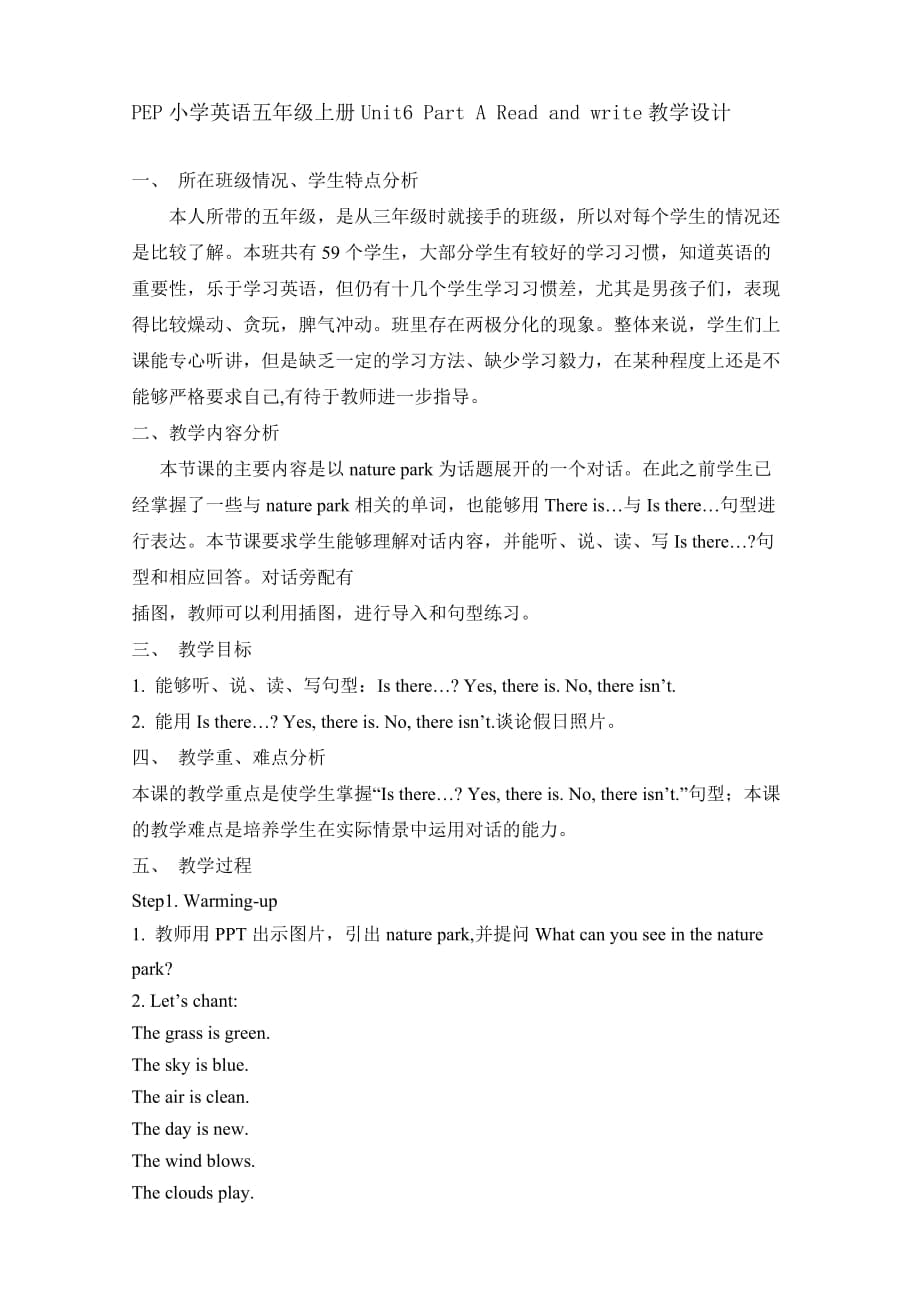《pep小學(xué)英語(yǔ)五年級(jí)上冊(cè)u(píng)nit6 part a read and write教學(xué)設(shè)計(jì)》由會(huì)員分享��,可在線閱讀�����,更多相關(guān)《pep小學(xué)英語(yǔ)五年級(jí)上冊(cè)u(píng)nit6 part a read and write教學(xué)設(shè)計(jì)(3頁(yè)珍藏版)》請(qǐng)?jiān)谘b配圖網(wǎng)上搜索��。
1��、PEP小學(xué)英語(yǔ)五年級(jí)上冊(cè)Unit6 Part A Read and write教學(xué)設(shè)計(jì)
一��、 所在班級(jí)情況����、學(xué)生特點(diǎn)分析
本人所帶的五年級(jí),是從三年級(jí)時(shí)就接手的班級(jí)��,所以對(duì)每個(gè)學(xué)生的情況還是比較了解����。本班共有59個(gè)學(xué)生,大部分學(xué)生有較好的學(xué)習(xí)習(xí)慣��,知道英語(yǔ)的重要性�,樂(lè)于學(xué)習(xí)英語(yǔ),但仍有十幾個(gè)學(xué)生學(xué)習(xí)習(xí)慣差�,尤其是男孩子們,表現(xiàn)得比較燥動(dòng)��、貪玩����,脾氣沖動(dòng)。班里存在兩極分化的現(xiàn)象��。整體來(lái)說(shuō)����,學(xué)生們上課能專心聽(tīng)講,但是缺乏一定的學(xué)習(xí)方法、缺少學(xué)習(xí)毅力�����,在某種程度上還是不能夠嚴(yán)格要求自己,有待于教師進(jìn)一步指導(dǎo)���。
二����、教學(xué)內(nèi)容分析
本節(jié)課的主要內(nèi)容是以nature park為話題展開(kāi)的一個(gè)對(duì)
2�����、話���。在此之前學(xué)生已經(jīng)掌握了一些與nature park相關(guān)的單詞�,也能夠用There is…與Is there…句型進(jìn)行表達(dá)�����。本節(jié)課要求學(xué)生能夠理解對(duì)話內(nèi)容�,并能聽(tīng)����、說(shuō)�����、讀�����、寫(xiě)Is there…?句型和相應(yīng)回答��。對(duì)話旁配有
插圖����,教師可以利用插圖����,進(jìn)行導(dǎo)入和句型練習(xí)。
三�����、 教學(xué)目標(biāo)
1. 能夠聽(tīng)�、說(shuō)、讀�����、寫(xiě)句型:Is there…? Yes, there is. No, there isn’t.
2. 能用Is there…? Yes, there is. No, there isn’t.談?wù)摷偃照掌?
四、 教學(xué)重�、難點(diǎn)分析
本課的教學(xué)重點(diǎn)是使學(xué)生掌握“Is there…? Y
3、es, there is. No, there isn’t.”句型�����;本課的教學(xué)難點(diǎn)是培養(yǎng)學(xué)生在實(shí)際情景中運(yùn)用對(duì)話的能力����。
五、 教學(xué)過(guò)程
Step1. Warming-up
1. 教師用PPT出示圖片����,引出nature park,并提問(wèn)What can you see in the nature park?
2. Let’s chant:
The grass is green.
The sky is blue.
The air is clean.
The day is new.
The wind blows.
The clouds play.
The river flow
4、s.
Beautiful day, beautiful day!
Step2. Lead-in & Before-reading
1. 教師出示只有forest和river的nature park. T: Is there a forest in the park?
S1: Yes, there is.
T: Is there a mountain in the park?
S2: No, there isn’t.
T: Is there a river in the park?
S3: Yes, there is.
T: Is there a lake in the par
5�、k?
S4: No, there isn’t.
2. Let’s chant:
Forest,forest Is there a forest? Mountain��,mountain Is there a mountain? River��,river Is there a river? Lake���,lake Is there a lake?
3.男女生分組對(duì)Let’s chant進(jìn)行問(wèn)答
G: Is there a forest in the park?
B: Yes, there is.
G: Is there a mountain in the park?
B: No, ther
6�����、e isn’t.
B: Is there a river in the park?
G: Yes, there is.
B: Is there a lake in the park?
G: No, there isn’t.
Step3. During-reading
1.出示Read and write旁邊的插圖
T: Who is he?
Ss: He is Wu Yifan.
T: Yes, this is Wu Yifan’s picture. This is Wu Yifan’s holiday picture. Is it a nature park? Ss: Ye
7���、s, it is.
T: Is there a forest in the park? Now read the dialogue quickly and find out the answer.
學(xué)生初讀課文,并找到答案Yes, there is.
2. Tick or cross
(1) There is a river in the park. (√)
(2) There is a lake in the park. ()
(3) Wu Yifan doesn’t like this park. ()
(4) This park is pretty. (√)
Ask a
8�、student to show his answers and check together. 學(xué)生第二次閱讀,更詳盡地理解閱讀內(nèi)容��,同時(shí)鼓勵(lì)學(xué)生
找出相關(guān)根據(jù)��,訓(xùn)練學(xué)生的邏輯思維能力���。
3. Finish the sentences
(1) Is there a ____ in the park? Yes,__________.
(2) Is there a ____? No,____________.
要求學(xué)生獨(dú)立完成句子����,同桌校對(duì)��,讓個(gè)別同學(xué)在黑板上寫(xiě)下他們的答案����。
4. Listen and repeat
Step4. After-reading
Role play
9、八��、課堂練習(xí)
出示課件,另一幅nature park的圖�,讓同桌兩人合作,一個(gè)學(xué)生就圖片內(nèi)容先寫(xiě)出問(wèn)題���,然后同桌就問(wèn)題寫(xiě)回答�����。到前面展示對(duì)話�。
九���、作業(yè)
1. Listen to tape and read the dialogue.
2. Write the sentences.
3. Talk about your pictures.
教學(xué)反思
本節(jié)我始終堅(jiān)持“任務(wù)型教學(xué)”的教育理念�����,通過(guò)三次閱讀課文�����,對(duì)學(xué)生提出不同層次的問(wèn)題��,讓學(xué)生帶著不同的任務(wù)去學(xué)習(xí)�,學(xué)生通過(guò)快速閱讀并圈出關(guān)鍵詞能很快找到問(wèn)題的答案�����,無(wú)需一詞一句地閱讀語(yǔ)篇��。學(xué)生在完成一個(gè)個(gè)任務(wù)中���,體驗(yàn)著成功的快樂(lè)��。本節(jié)課還有以下幾個(gè)特點(diǎn):1. 突出合作的教學(xué)理念����;2. 突出以學(xué)生為主體的教學(xué)理念����;3. 突出學(xué)以致用的教學(xué)理念。
 pep小學(xué)英語(yǔ)五年級(jí)上冊(cè)u(píng)nit6 part a read and write教學(xué)設(shè)計(jì)
pep小學(xué)英語(yǔ)五年級(jí)上冊(cè)u(píng)nit6 part a read and write教學(xué)設(shè)計(jì)

